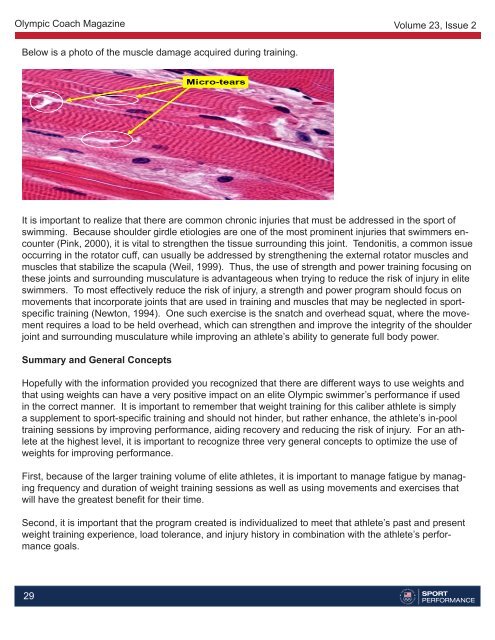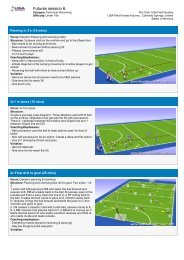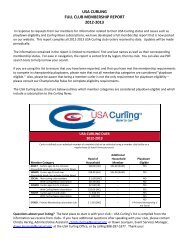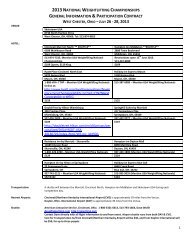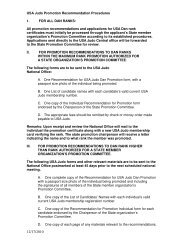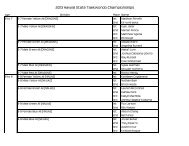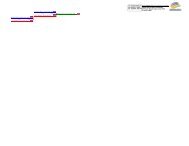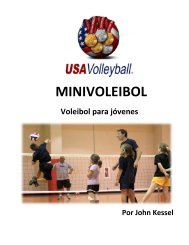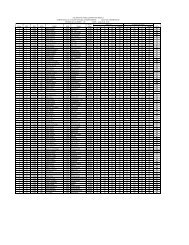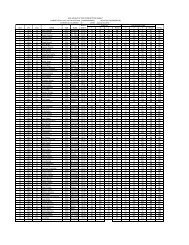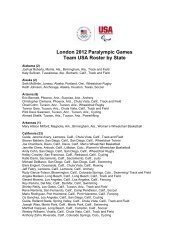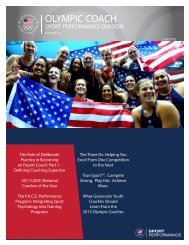Strength and Power for the Elite Swimmer 2012 - United States ...
Strength and Power for the Elite Swimmer 2012 - United States ...
Strength and Power for the Elite Swimmer 2012 - United States ...
You also want an ePaper? Increase the reach of your titles
YUMPU automatically turns print PDFs into web optimized ePapers that Google loves.
Olympic Coach Magazine<br />
Below is a photo of <strong>the</strong> muscle damage acquired during training.<br />
29<br />
Volume 23, Issue 2<br />
It is important to realize that <strong>the</strong>re are common chronic injuries that must be addressed in <strong>the</strong> sport of<br />
swimming. Because shoulder girdle etiologies are one of <strong>the</strong> most prominent injuries that swimmers encounter<br />
(Pink, 2000), it is vital to streng<strong>the</strong>n <strong>the</strong> tissue surrounding this joint. Tendonitis, a common issue<br />
occurring in <strong>the</strong> rotator cuff, can usually be addressed by streng<strong>the</strong>ning <strong>the</strong> external rotator muscles <strong>and</strong><br />
muscles that stabilize <strong>the</strong> scapula (Weil, 1999). Thus, <strong>the</strong> use of strength <strong>and</strong> power training focusing on<br />
<strong>the</strong>se joints <strong>and</strong> surrounding musculature is advantageous when trying to reduce <strong>the</strong> risk of injury in elite<br />
swimmers. To most effectively reduce <strong>the</strong> risk of injury, a strength <strong>and</strong> power program should focus on<br />
movements that incorporate joints that are used in training <strong>and</strong> muscles that may be neglected in sportspecific<br />
training (Newton, 1994). One such exercise is <strong>the</strong> snatch <strong>and</strong> overhead squat, where <strong>the</strong> movement<br />
requires a load to be held overhead, which can streng<strong>the</strong>n <strong>and</strong> improve <strong>the</strong> integrity of <strong>the</strong> shoulder<br />
joint <strong>and</strong> surrounding musculature while improving an athlete’s ability to generate full body power.<br />
Summary <strong>and</strong> General Concepts<br />
Hopefully with <strong>the</strong> in<strong>for</strong>mation provided you recognized that <strong>the</strong>re are different ways to use weights <strong>and</strong><br />
that using weights can have a very positive impact on an elite Olympic swimmer’s per<strong>for</strong>mance if used<br />
in <strong>the</strong> correct manner. It is important to remember that weight training <strong>for</strong> this caliber athlete is simply<br />
a supplement to sport-specific training <strong>and</strong> should not hinder, but ra<strong>the</strong>r enhance, <strong>the</strong> athlete’s in-pool<br />
training sessions by improving per<strong>for</strong>mance, aiding recovery <strong>and</strong> reducing <strong>the</strong> risk of injury. For an athlete<br />
at <strong>the</strong> highest level, it is important to recognize three very general concepts to optimize <strong>the</strong> use of<br />
weights <strong>for</strong> improving per<strong>for</strong>mance.<br />
First, because of <strong>the</strong> larger training volume of elite athletes, it is important to manage fatigue by managing<br />
frequency <strong>and</strong> duration of weight training sessions as well as using movements <strong>and</strong> exercises that<br />
will have <strong>the</strong> greatest benefit <strong>for</strong> <strong>the</strong>ir time.<br />
Second, it is important that <strong>the</strong> program created is individualized to meet that athlete’s past <strong>and</strong> present<br />
weight training experience, load tolerance, <strong>and</strong> injury history in combination with <strong>the</strong> athlete’s per<strong>for</strong>mance<br />
goals.


